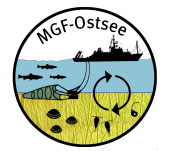Cruise reports 2021
Clupea 351
From 18 January to 5 February 2021, the Clupea visited the Fehmarnbelt and Oderbank protected areas to conduct studies on changes in the benthic and demersal fish community before and after the exclusion of mobile bottom-dwelling fishing gear.
EMB 267
From 01.06.2021 - 16.06.2021 the second comprehensive sampling of the marine nature reserves of the Baltic Sea took place. The main goal and purpose of the sampling this time: the Oderbank nature reserve and the categorisation of its bottom-dwelling faunal communities from bacteria, small crustaceans and worms to mussels and starfish, but also the smallest algae. In addition, mapping work was carried out, i.e. surveys of the seabed. The Fehmarnbelt protected area was also mapped a second time. In addition, comparative areas outside the protected areas were sampled. This comprehensive survey of the current state is to provide a baseline that will later serve as a reference for the further development of the areas after the exclusion of bottom-dwelling fisheries in the protected areas.
Solea 793
The aim of the sub-project is to assess changes in the demersal and benthic fish fauna in marine protected areas after exclusion of bottom-dwelling fishing gear. During the expedition, study areas in the protected areas were fished and compared with comparable reference areas outside the protected areas. Furthermore, a towed line in the area off Nienhagen (close to the city of Rostock) was examined directly after fishing by a commercial fishing vessel was investigated in order to establish methods for measuring the direct effects of bottom-dwelling fishing. In addition to FFS Solea and a commercial fishing vessel the FS Elisabeth Mann Borgese (IOW), FK Klaashahn (IOW) and FK Limanda (University of Rostock), partly with divers, were involved in the investigations.
EMB268 experimental cruise
During the cruise between 18.06.2021-21.06.2021 a trawl experiment was carried out in cooperation with the Thünen Institute and the University of Rostock. The main objectives of the research were to gain a better understanding of the sustainability of seabed habitats and biota in the protected areas under the current bottom trawl operation, to generally assess the impact of bottom contact fisheries on benthic communities and sediment functions, and to follow the development of the areas after fisheries exclusion. Specifically, changes in sediment morphology, geology, biology and geochemistry were recorded through targeted sampling.

